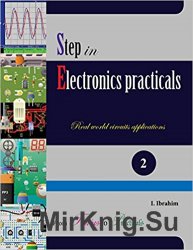Название :Step in Electronics Practicals: Real world circuits applications
Издательство :CreateSpace Independent Publishing Platform (Volume 2)
Автор :Ibrahim Ibyimanikora
Год :2015
Количество страниц :444
Язык :русский
Формат : pdf, azw4
Размер :59 Mb
The field of electronics is very diverse, and career opportunities are available in many areas. Because electronics is currently found in so many different applications and new technology is being developed at a fast rate, its feature appears limitless. There is hardly an area of our lives that is not enhanced to some degree by electronics technology.
The study of electronics is one of the basic steps in gaining an understanding of all modern technology and science also; our everyday life depends a lot on the electronic. So this book of step in electronics practicals provides a comprehensive and clear coverage of electronic practical concepts, practical applications and troubleshooting. It is designed to cover a wide range of topics that make up the field of electronics in well-organized and highly informative manner. Special emphasis is placed on practical applications; thus, this book in not theoretical one, but an enlightening practicals of the usefulness of rapidly growing field of electronics. In this book many topics have been strengthened and some topics, innovative and features have been added related to the real world. These practical topics are coordinated with the text showing working principles and their practical design and will make any candidate to be more effective in practical application. Additionally, real world circuits design make the book more visually interesting and easier to use. The circuit provided have been simulated using reliable and accurate method and tested using real components. The presentation is tutorial in nature in order to enhance the value of the book to the reader and foster a clear understanding of practical project topics. This Step in Electronics Practicals book will provide the required practical skills that is useful for ENGINEERING STUDENTS and PRACTICING PROFESSIONALS. Over hundred projects have been discussed in this book that give a clear coverage of real world applications and openness to develop any electronics project that respond to day to day person needs.
Circuit Designation and Circuit Workplace
depositfiles.com turbobit.net
ОТСУТСТВУЕТ ССЫЛКА/ НЕ РАБОЧАЯ ССЫЛКА ЕСТЬ РЕШЕНИЕ, ПИШИМ СЮДА!


